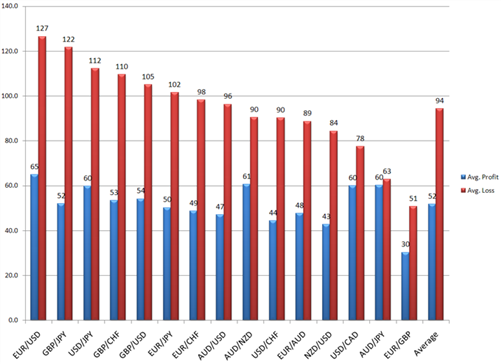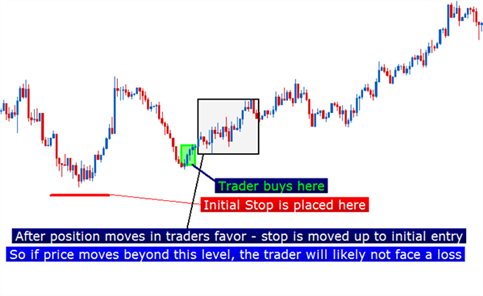Talking Points:
- In the Top Trading Mistake, we saw how risk-reward ratios can have a large impact on performance.
- Traders should look to minimize their risk on each trade, using stops to reinforce the ‘maximum loss.’
- Traders can then look to maximize reward potential with trade management.
Have you ever had that trade that, at least
initially, looked like it was going to work out better than you had
initially hoped for?
You keep your limit on the position, and comfortably
walk away from the trade knowing that your analysis, your strategy, and
your hard work have all paid off. It feels as if it’s as good as ‘money
in the bank.’
When you come back to check on the position,
counting the profits in your head you realize that something has gone
terribly wrong. The trade that once looked like a sure-fire win has
turned around, and ran straight to your stop-loss.
You look at your equity; dejected from this ugly and
unwelcomed surprise, and it finally sinks in: This trade that once
looked like it was ‘in the bank’ actually turned into a loss. And your
equity stares you in the face with only a fraction of the funds that
were previously there. Disappointment reigns supreme.
This is one of the most unsavory aspects of trading.
Dealing with this type of dejection isn’t easy for most in a game where
rejection is a common (and regular) part of reality. This is also
psychological torture, and leads many to fall victim to the Top Trading Mistake.
Most rationale people will respond accordingly… and
the next time they see profits on the table they take them off quicker
than your or I can say ‘close.’
But is this really the best thing to do?
Is there no other way to proactively plan around this issue?
Do you think the titans of this industry, be it Paul
Tudor Jones or Warren Buffett, skirmish to quickly take profits out of
fear of watching a winner become a loser?
No. As a matter of fact, Mr. Buffett has a very famous quote on this very topic:
‘Be fearful when others are greedy, and be greedy when others are fearful.’
In this article, we’ll attempt to teach you how to do that.
Why Taking ‘Quick’ Profits Can be Destructive
The Top Trading Mistake is inverse risk-reward
ratios, or to put it simply: Traders can lose so much more when they are
wrong than they make when they are right that even winning 60 or 70% of
the time produces net losses to the portfolio.
DailyFX did an extensive research study on this very topic, and this was found to be The Number One Mistake that Forex Traders Make, authored by Mr. David Rodriguez. They take very small profits, and very large losses.
Traders took far bigger losses when they were wrong, than they made when they were right

Taken from The Number One Mistake Forex Traders Make, by David Rodriguez
This is indicative of traders entering positions
without a plan for exit. Traders initiate a position for any number of
reasons, whether they be technical, fundamental, spiritual, whatever;
and they hope for the best.
When that doesn’t pan out, they scurry around the
trade leaving their fate up to the ability to react in just the right
way at just the right time. This is often a practice in futility.
More regularly, what happens when the trade moves in
their favor is that they quickly close the position out. Being fearful
that this gain might turn around and become a loss, most traders get an
element of fear when, as Warren Buffett points out, they should be
greedy.
On the other side of the matter, if the position
moves against them, they often hold on. They want to win, and this is
very natural. This is a trader being greedy when, in fact, they should
be fearful. Unfortunately, this story often gets uglier from here. As
the position moves further against them, many traders will dig their
heels in even deeper.
‘Price has always come back to XYZ level, I just need to be patient.’
Oh ya? Tell that to the folks that bought GBPJPY at 250.00 in 2007.
Stops can keep you out of very bad positions

Created with Marketscope/Trading Station II; prepared by James Stanley
A quote from John Maynard Keynes on the matter: “The market can remain irrational far longer than you can remain solvent.”
Taking quick profits is so dangerous because these
smaller profit amounts can’t offset larger losses. And because the
future (and price movements are unpredictable), traders have to be
prepared to lose on any individual position.
This is Where the Plan Comes In
The maximum loss a trader is willing to take should
be calculated before any trade is ever triggered. Decide at what point
you want to exit the trade because that idea didn’t work out. This is
the first part of learning how to lose properly.
Provided that traders are using moderate-to-lower levels of leverage (which was our Top Trading Mistake #2), any one loss shouldn’t have a huge impact to a trader’s account.
Once the maximum loss is set for the position, the trader can place a stop
at that level so that the trade will automatically close if that price
is hit in the market. This is like packing your parachute before you go
skydiving; or filling your oxygen tank before scuba diving.
The stop is what helps you stay alive in markets,
and prevents one trade from taking 20 or 30% of your capital away on any
one, individual idea.
After the maximum loss has been set, the trader can
then start plotting the profit-side of the position. As recommended in
Traits of Successful Traders, the minimum reward should be at least as large as the initial stop.
So, if your stop is 150 pips away from your entry price, the minimum reward should be at least 150 pips away from the entry.
But just as Warren Buffet said, traders should be
greedy when others are fearful: So, should you really take that profit
just because you realized a 1-to-1 risk-to-reward ratio?
No. This is when others are fearful; fearful of
failure and fearful that the position will turn around against them and
run to their stop.
Save your fear for positions that lose money. When a
position works in the way that you had wanted, and your hypothesis for
triggering the trade is proven correct: This is the time to start being
greedy.
How to ‘Have Your Cake and Eat it Too’
Traders need to realize that regardless of when they
entered the trade, or how much of a profit or loss has been accumulated
– future price movements are always unpredictable.
There is no ultimate ‘right’ answer as to whether
any one trade should be completely closed out with profits taken
off-of-the-table, or whether it should be allowed to run so that bigger
profits might be obtained.
Instead, traders can utilize a series of trade
management techniques to try to take advantage of either situation, and
once again having a plan before triggering the trade can assist.
Traders can look to scale out of winning positions
as prices move in their favor, closing a portion of the trade as prices
move more aggressively in their favor. This way, traders can take some
profit off-of-the-table so that in the worse-case-scenario (as we
examined at the beginning of this article), they have something to show
for their work.
Learning to scale-out of a position can be rather
complicated, so I highly recommend trying this type of trade management
on a demo account before ever using it in a live trade. Demo accounts
are free, and remove the risk of financial loss. I fully realize that
trading demo dollars isn’t nearly as fun as having money on the line,
but trading should be about profitability; not fun. Click here to sign up for a free demo account through FXCM.
A break-even stop
can also be utilized so that in the event that price reverses on the
remainder of the position, a loss doesn’t wipe away the accumulated
profit.
A Break-Even Stop Can Function as Protection on the Remainder of the Position When Scaling-Out

Taken from The Break-Even Stop, by James Stanley
After the break-even stop has been set, traders can
begin to discount the fear losing money on the trade. Once again, this
is where greed, and not fear, should guide the trader’s decisions.
As prices continue moving in the direction the
trader is looking for, additional parts of the position can be closed.
If prices do reverse, the break-even stop is there to take the position
out at the original entry price.
Most importantly, this allows a trader to prevent
fear from taking away profit potential. If the trade has more upside
left, the trader is in a position to capitalize on that by scaling-out
of the winning trade as prices move in their favor.
And what if price never moves in their favor? Well,
that’s what the initial stop is there for. Future price movements are
always unpredictable, whether we’re in the trade already or not. The
best we can do as traders and as human beings is to try to get the most
out of each situation without losing too much on any one idea.
No comments:
Post a Comment